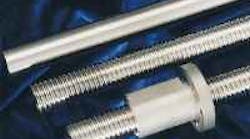Collaborating with a machine tool builder results in a more precise ballscrew.
At 20th Century Machine Co., materials proceed from 4150 hardened steel stock to finished ballscrews quickly and accurately.
The Mitsui Seiki GSE-200B thread grinder has reduced production time per part from 4 hr down to 30 min.
A 3-axis CNC diamond unit dresses CBN wheels, and up to 15 lead screws are ground between each dressing.
The quality assurance department at 20th Century verifies that peaks and valleys are ground to within 0.000030 in. on the Mitsui Seiki grinder.
In recent years, specifications and tolerance requirements for ballscrews have become much more demanding, mainly because major automakers and key product manufacturers want increased production volumes and faster cycle times. Some machine tool builders are answering these demands with faster axis travels to take full advantage of today's high speed spindles and new tooling technologies. But moving faster requires more precisely manufactured ballscrews, and for one ballscrew manufacturer, keeping ahead of the game means not always working alone.
The 20th Century Machine Co. in Armada, Mich., collaborated with Mitsui
Seiki Inc., Franklin, N.J., to develop a CNC thread grinder for accurate ballscrew production. That means making ballscrews with concentricity of the journals to the screw O.D. that is
0.0005 in. or better, squareness of the nut flange to the screw of 0.0005 in. TIR, and thread lead tolerance that is 0.003 in. for commercial units and as close as 0.0002 in./ft for precision units.
The grinder, a Mitsui Seiki GSE-200B, handles 20th Century's 4150 steel screws in lengths up to 86 in. between centers with up to a 78-in. maximum thread length. Work spindle speeds range from 0.1 to 100 rpm with the low speed range conducive to inspection of finished threads right on the machine. Pre-settable table travel and positioning is 0.0001 in., and lead compensation can be programmed in 0.0001-in. increments.
For grinding long threads, the table retracts rapidly without rotating the workpiece to prevent heat generation from friction between the work, steady rest, and work spindle mechanism. For accurate lead control, operators simply enter the amount of lead compensation into the machine's CNC.
"There are actually two CNCs," says Gus Dabringhaus, president and owner of 20th Century, "a 3-axis control for the thread grinder and a separate 3-axis control for the wheel dresser, which incorporates hand-set diamonds and has an adjustable control, visual-touch center, and a Hioki unit that prints out the touch of dresser against wheel."
The company runs CBN wheels at speeds up to 3,300 rpm. Because of these high wheel speeds, an anti-foaming agent is added to the lubricant. The high speeds and feeds of the thread grinder also contribute to some dramatic changes in ballscrew throughput.
"For instance, we do a lot of ballscrews for machining centers," says Dabringhaus. "A typical one measures 1 1/4 in. in diameter, 28 in. long, and is heat treated before threading . Using conventional thread grinders, we complete one every 4 hours. With the Mitsui Seiki, it takes only 30 minutes . That's an 800% production boost."
He continues, "As for quality from this machine, we're seeing 0.000030-in. tolerance , peak to valley, with less than 3-rms surface f inishes . That's high quality precision and it's repeatable; every part is identical in the batch run. And , we're getting about fifteen parts per dress. That saves time and money."










